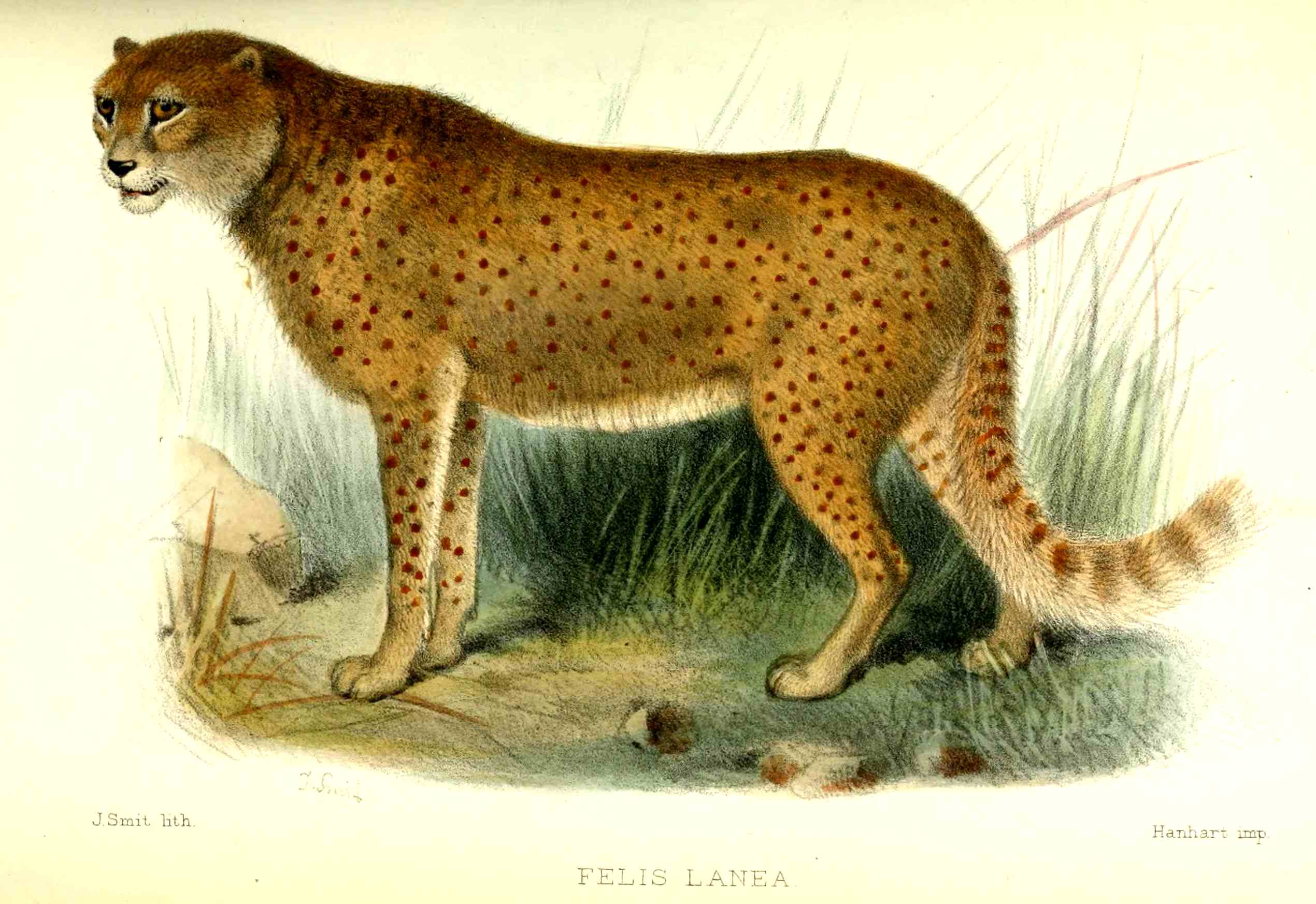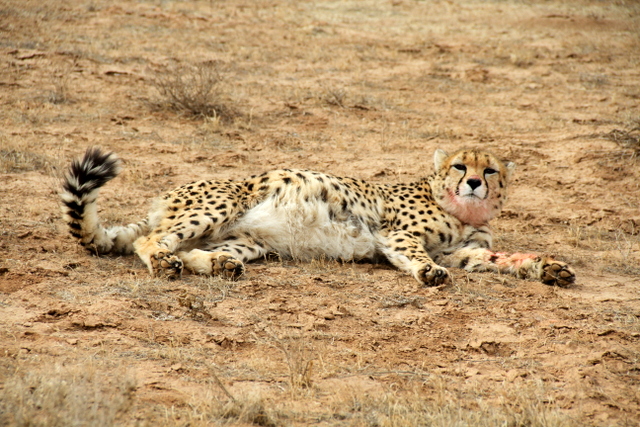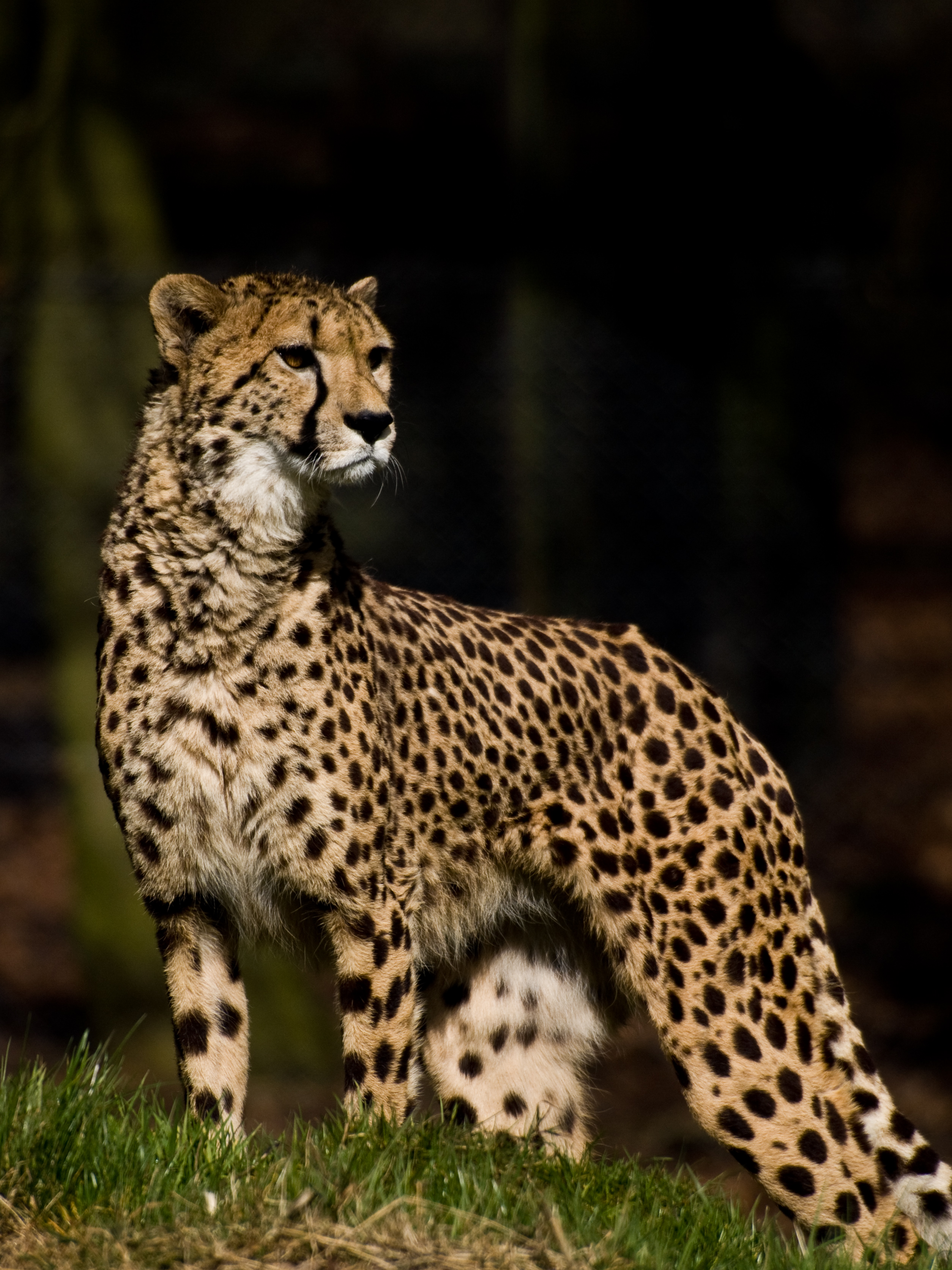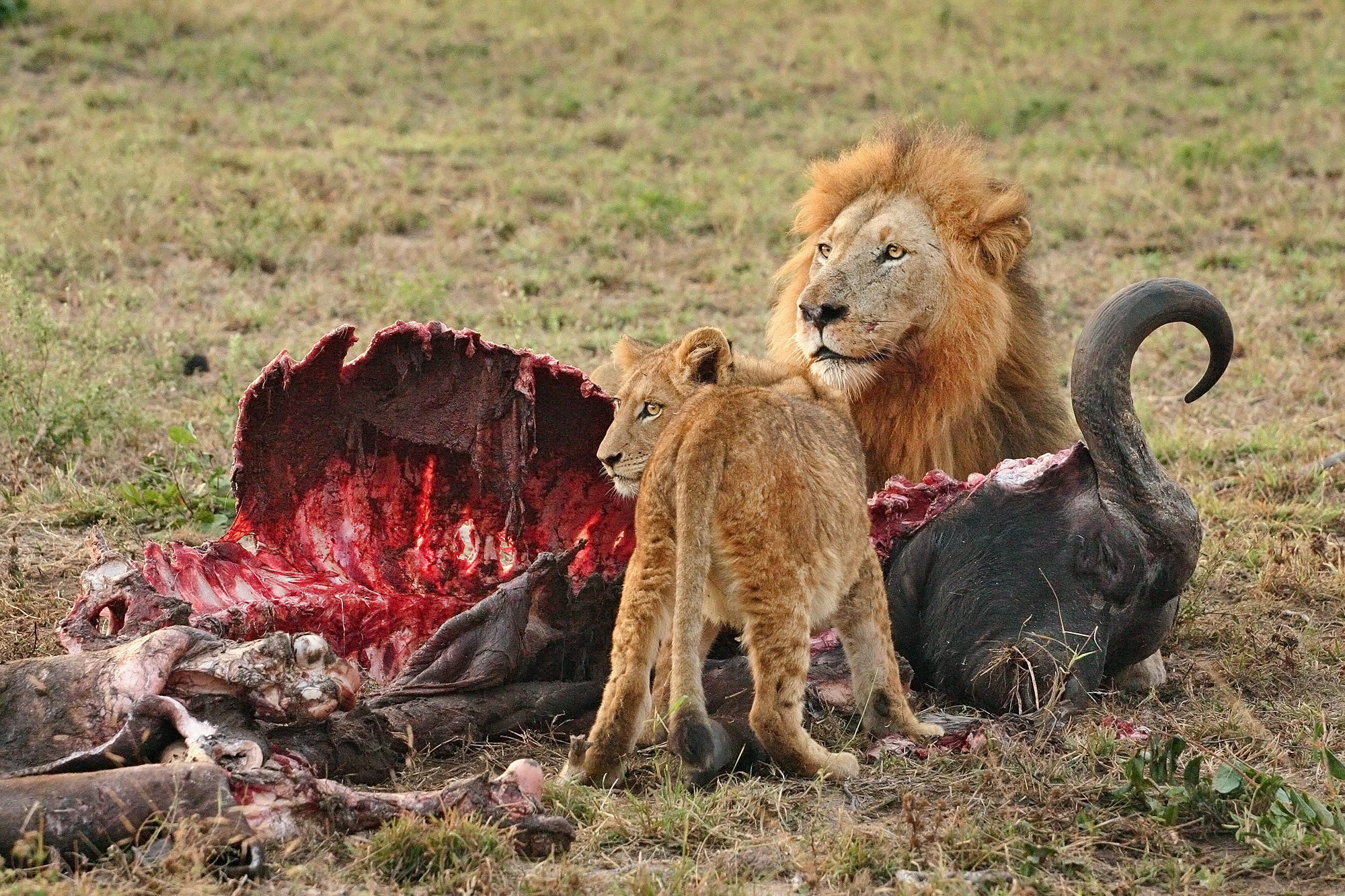|
Cheetah
The cheetah (''Acinonyx jubatus'') is a large cat native to Africa and central Iran. It is the fastest land animal, estimated to be capable of running at with the fastest reliably recorded speeds being , and as such has evolved specialized adaptations for speed, including a light build, long thin legs and a long tail. It typically reaches at the shoulder, and the head-and-body length is between . Adults weigh between . Its head is small and rounded, with a short snout and black tear-like facial streaks. The coat is typically tawny to creamy white or pale buff and is mostly covered with evenly spaced, solid black spots. Four subspecies are recognised. The cheetah lives in three main social groups: females and their cubs, male "coalitions", and solitary males. While females lead a nomadic life searching for prey in large home ranges, males are more sedentary and instead establish much smaller territories in areas with plentiful prey and access to females. The cheetah is a ... [...More Info...] [...Related Items...] OR: [Wikipedia] [Google] [Baidu] |
Southeast African Cheetah
The Southeast African cheetah (''Acinonyx jubatus jubatus'') is the nominate cheetah subspecies native to East and Southern Africa. The Southern African cheetah lives mainly in the lowland areas and deserts of the Kalahari, the savannahs of Okavango Delta, and the grasslands of the Transvaal region in South Africa. In Namibia, cheetahs are mostly found in farmlands. Taxonomy The Southern African cheetah was first described by German naturalist Johann Christian Daniel von Schreber in his book ''Die Säugethiere in Abbildungen nach der Natur mit Beschreibungen'' (''The Mammals illustrated as in Nature with Descriptions''), published in 1775. Schreber described the species on basis of a specimen from the Cape of Good Hope. It is therefore the nominate subspecies. Subpopulations have been called "South African cheetah" and "Namibian cheetah." Following Schreber's description, other naturalists and zoologists also described cheetah specimens from many parts of Southern and Ea ... [...More Info...] [...Related Items...] OR: [Wikipedia] [Google] [Baidu] |
Asiatic Cheetah
The Asiatic cheetah (''Acinonyx jubatus venaticus'') is a critically endangered cheetah subspecies currently only surviving in Iran. It once occurred from the Arabian Peninsula and the Near East to the Caspian region, Transcaucasus, Kyzylkum Desert and northern South Asia, but was extirpated in these regions during the 20th century. The Asiatic cheetah diverged from the cheetah population in Africa between 32,000 and 67,000 years ago. The Asiatic cheetah survives in protected areas in the eastern-central arid region of Iran, where the human population density is very low. Between December 2011 and November 2013, 84 individuals were sighted in 14 different protected areas, and 82 individuals were identified from camera trap photographs. In December 2017, fewer than 50 individuals were thought to be remaining in three subpopulations that are scattered over in Iran's central plateau. As of January 2022, the Iranian Department of Environment estimates that only 12 Asiati ... [...More Info...] [...Related Items...] OR: [Wikipedia] [Google] [Baidu] |
Northeast African Cheetah
The Northeast African cheetah (''Acinonyx jubatus soemmeringii'') is a cheetah subspecies occurring in Northeast Africa. Contemporary records are known in South Sudan and Ethiopia, but population status in Eritrea, Djibouti, Somalia and Sudan is unknown. It was first described under the scientific name ''Cynailurus soemmeringii'' by the Austrian zoologist Leopold Fitzinger in 1855 on the basis of a specimen from Sudan’s Bayuda Desert brought to the Tiergarten Schönbrunn in Vienna. It is also known as the Sudan cheetah. In the 1970s, the cheetah population in Ethiopia, Sudan and Somalia was roughly estimated at 1,150 to 4,500 individuals. In 2007, it was estimated that 950 individuals live inside protected areas in this region; the number of individuals living outside protected areas is unknown. This subspecies is more closely related to the Southern African cheetah than to Saharan cheetah populations. Results of a phylogeographic analysis indicate that the two subspecies d ... [...More Info...] [...Related Items...] OR: [Wikipedia] [Google] [Baidu] |
Northwest African Cheetah
The Northwest African cheetah (''Acinonyx jubatus hecki''), also known as the Saharan cheetah, is a cheetah subspecies native to the Sahara and the Sahel. It is listed as Critically Endangered on the IUCN Red List. In 2008, the population was suspected to number less than 250 mature individuals. The Northwest African cheetah was scientific description, described by German people, German zoologist Max Hilzheimer in 1913 under the Taxonomy (biology), scientific name ''Acinonyx hecki''. Taxonomy ''Felis jubata senegalensis'' was described by Henri Marie Ducrotay de Blainville in 1843 based on a cheetah from Senegal. As this name was preoccupied, it is considered Synonym (taxonomy), synonymous with ''A. j. hecki''. ''Acinonyx hecki'' was the scientific name proposed by :de: Max Hilzheimer, Max Hilzheimer in 1913, based upon a captive cheetah in the Berlin Zoological Garden that also originated in Senegal. Characteristics The Northwest African cheetah is quite different in appearan ... [...More Info...] [...Related Items...] OR: [Wikipedia] [Google] [Baidu] |
Fastest Animals
This is a list of the fastest animals in the world, by types of animal. Fastest organism The fastest land animal is the cheetah. The peregrine falcon is the fastest bird, and the fastest member of the animal, animal kingdom, with a Descent (aeronautics)#Dives, diving speed of . Among the fastest animals in the sea is the black marlin, with uncertain and conflicting reports of recorded speeds. When drawing comparisons between different classes of animals, an alternative unit is sometimes used for organisms: ''body length per second''. On this basis the 'fastest' organism on earth, relative to its body length, is the Southern Californian mite, ''Paratarsotomus macropalpis'', which has a speed of 322 body lengths per second. The equivalent speed for a human, running as fast as this mite, would be . The speed of the ''P. macropalpis'' is far in excess of the previous record holder, the Australian tiger beetle ''Cicindela eburneola'', which is the fastest insect in the world rel ... [...More Info...] [...Related Items...] OR: [Wikipedia] [Google] [Baidu] |
Thomson's Gazelle
Thomson's gazelle (''Eudorcas thomsonii'') is one of the best known species of gazelles. It is named after explorer Joseph Thomson (explorer), Joseph Thomson and is sometimes referred to as a "tommie". It is considered by some to be a subspecies of the red-fronted gazelle and was formerly considered a member of the genus ''Gazella'' within the subgenus ''Eudorcas'', before ''Eudorcas'' was elevated to genus status. Thomson's gazelles can be found in numbers exceeding 200,000 in Africa and are recognized as the most common type of gazelle in East Africa. A small fast antelope, the Thomson's gazelle is claimed to have top speeds up to . It is the fourth-fastest land animal, after the cheetah (its main predator), pronghorn, and springbok. Taxonomy and etymology The current scientific name of Thomson's gazelle is ''Eudorcas thomsonii''. It is a member of the Genus (biology), genus ''Eudorcas'' and is classified under the Family (biology), family Bovidae. Thomson's gazelle was first Sc ... [...More Info...] [...Related Items...] OR: [Wikipedia] [Google] [Baidu] |
Sabi Sand Game Reserve
Sabi Sand Game Reserve is located adjacent to the Kruger National Park in the Lowveld of Mpumalanga, South Africa. Officially named Sabi Sand Wildtuin, the Sabi Sand Game Reserve consists of a group of private game reserves. The Newington Gate is at and west of the Kruger Gate and Skukuza camp of Kruger Park. Other entrances are Gowrie Gate in the far north and Shaws Gate in the south. The park's name comes from the Sabie River on its southern boundary and the Sand River (Mpumalanga), Sand River flowing through it. The area of the reserve is and it shares a non-fenced boundary of with the Kruger National Park to its east. Reserves in Sabi Sand include Buffelshoek, Djuma Game Reserve, Djuma, Elephant Plains, Cheetah Plains, Mala Mala Game Reserve, Mala Mala, Chitwa Chitwa, Nkorho, Simbambili, Arathusa, Londolozi Private Game Reserve, Londolozi, Umzumbe, Umkumbe, Nottens, Sabi Sabi, Lion Sands Reserve, Lion Sands, Kirkman's Kamp, Singita, Exeter Leadwood, Inyati, Idube, Dulin ... [...More Info...] [...Related Items...] OR: [Wikipedia] [Google] [Baidu] |
Felidae
Felidae () is the family of mammals in the order Carnivora colloquially referred to as cats, and constitutes a clade. A member of this family is also called a felid (). The term "cat" refers both to felids in general and specifically to the domestic cat ('' Felis catus''). Felidae species exhibit the most diverse fur pattern of all terrestrial carnivores. Cats have retractile claws, slender muscular bodies and strong flexible forelimbs. Their teeth and facial muscles allow for a powerful bite. They are all obligate carnivores, and most are solitary predators ambushing or stalking their prey. Wild cats occur in Africa, Europe, Asia and the Americas. Some wild cat species are adapted to forest habitats, some to arid environments, and a few also to wetlands and mountainous terrain. Their activity patterns range from nocturnal and crepuscular to diurnal, depending on their preferred prey species. Reginald Innes Pocock divided the extant Felidae into three subfamilies: th ... [...More Info...] [...Related Items...] OR: [Wikipedia] [Google] [Baidu] |
Joshua Brookes
Joshua Brookes (24 November 1761 – 10 January 1833) was a British anatomist and naturalist. Early life Brookes studied under William Hunter, William Hewson, Andrew Marshall, and John Sheldon, in London. He then attended the practice of Antoine Portal and other eminent surgeons at the Hôtel-Dieu de Paris. Brookesian Museum Brookes became a teacher of anatomy in London, and the founder of the Brookesian Museum of Comparative Anatomy. This private museum is described in the 1830 catalogue ''Museum Brookesianum''. Later life Elected a Fellow of the Royal Society in 1819, Brookes gave up teaching in 1826, in bad health. After vainly endeavouring to dispose of his museum collection entire, he sold it off piecemeal. The final sale took place on 1 March 1830, and on 22 following days. He died on 10 January 1833 in Great Portland Street, London. Works Brookes was the first to place the Cheetah in its own genus, which he established in 1828 as ''Acinonyx''. His published ... [...More Info...] [...Related Items...] OR: [Wikipedia] [Google] [Baidu] |
Pleistocene
The Pleistocene ( , often referred to as the '' Ice age'') is the geological epoch that lasted from about 2,580,000 to 11,700 years ago, spanning the Earth's most recent period of repeated glaciations. Before a change was finally confirmed in 2009 by the International Union of Geological Sciences, the cutoff of the Pleistocene and the preceding Pliocene was regarded as being 1.806 million years Before Present (BP). Publications from earlier years may use either definition of the period. The end of the Pleistocene corresponds with the end of the last glacial period and also with the end of the Paleolithic age used in archaeology. The name is a combination of Ancient Greek grc, label=none, πλεῖστος, pleīstos, most and grc, label=none, καινός, kainós (latinized as ), 'new'. At the end of the preceding Pliocene, the previously isolated North and South American continents were joined by the Isthmus of Panama, causing a faunal interchange between the t ... [...More Info...] [...Related Items...] OR: [Wikipedia] [Google] [Baidu] |
Snout
A snout is the protruding portion of an animal's face, consisting of its nose, mouth, and jaw. In many animals, the structure is called a muzzle, rostrum, or proboscis. The wet furless surface around the nostrils of the nose of many mammals is called the rhinarium (colloquially this is the "cold wet snout" of some mammals). The rhinarium is often associated with a stronger sense of olfaction. Variation Snouts are found on many mammals in a variety of shapes. Some animals, including ursines and great cats, have box-like snouts, while others, like shrews, have pointed snouts. Pig snouts are flat and cylindrical. Primates Strepsirrhine primates have muzzles, as do baboons. Great apes have reduced muzzles, with the exception being human beings, whose face does not have protruding jaws nor a snout but merely a human nose. Dogs The muzzle begins at the stop, just below the eyes, and includes the dog's nose and mouth. In the domestic dog, most of the upper muzzle contains org ... [...More Info...] [...Related Items...] OR: [Wikipedia] [Google] [Baidu] |
Iran
Iran, officially the Islamic Republic of Iran, and also called Persia, is a country located in Western Asia. It is bordered by Iraq and Turkey to the west, by Azerbaijan and Armenia to the northwest, by the Caspian Sea and Turkmenistan to the north, by Afghanistan and Pakistan to the east, and by the Gulf of Oman and the Persian Gulf to the south. It covers an area of , making it the 17th-largest country. Iran has a population of 86 million, making it the 17th-most populous country in the world, and the second-largest in the Middle East. Its largest cities, in descending order, are the capital Tehran, Mashhad, Isfahan, Karaj, Shiraz, and Tabriz. The country is home to one of the world's oldest civilizations, beginning with the formation of the Elamite kingdoms in the fourth millennium BC. It was first unified by the Medes, an ancient Iranian people, in the seventh century BC, and reached its territorial height in the sixth century BC, when Cyrus the Gr ... [...More Info...] [...Related Items...] OR: [Wikipedia] [Google] [Baidu] |




_Gazella_isabella_(white_background).png)


